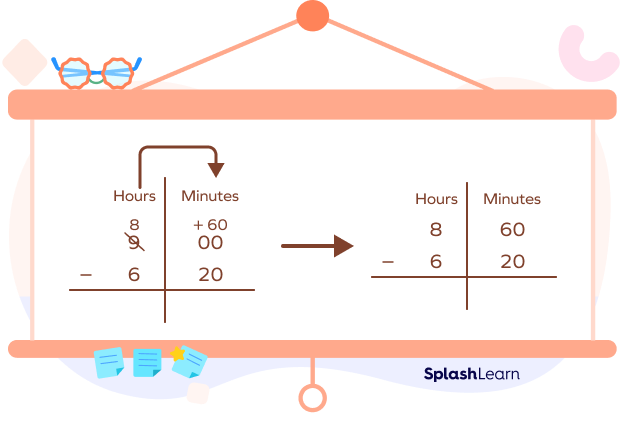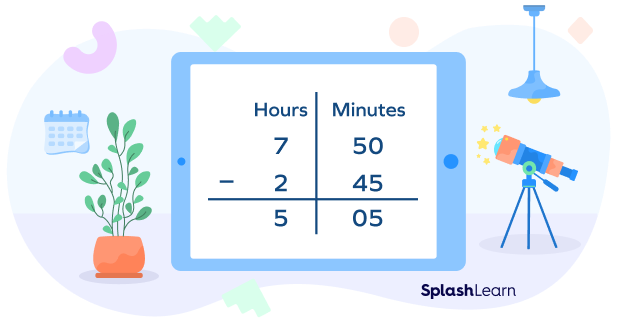Introduction
Time tells us about the duration of an activity or event during the day. Understanding the concept of time is essential to plan our daily activities. We measure time in hours, minutes, and seconds. Do you think it is possible to add or subtract time in hours, minutes, and seconds? In this article, we will learn how to subtract time. Let’s get started!
Recommended Games
What is Subtracting Time?
Subtracting time in math is the process of finding the difference between distinct units of time, such as hours, minutes, and seconds and then combining them. Subtracting time is slightly different from subtracting regular numbers since we need to consider time conversion. There are 60 seconds in 1 minute, 60 minutes in 1 hour, and 24 hours in a day.

There are numerous situations in our daily life where we apply the concept of time subtraction. For example, to calculate the duration of a journey or to find the course of a class. It is important to understand that the elapsed time or duration of an activity means the difference between two times (the start and the end time of the activity).
We can subtract time using a simple procedure. The formula for time subtraction is very straightforward. We can start by subtracting the minutes and then advance to subtracting the hours to derive the difference.
Recommended Worksheets
How to Subtract Time
We can follow a simple process to subtract time in hours and minutes by hand. Let us look at the method to subtract Time B from Time A or Time A — Time B:
Step I: Compare the minute of both times.
Case 1: If the minutes of “time A” is less than the minutes of “time B,” then in “time A.”
- Take one hour away.
- Add 60 to the minutes.
Case 2: If the minutes of “time A” is more than the minutes of “time B,” jump to step 2 directly.
Step II: Subtract the minutes of both times.
Step III: Subtract the hours of both times.
Hence, the answer is the result of Steps II and III together.
For example, calculate the difference between 6:20 and 9:00.
Step I: 9:00 $-$ 6:20. The minutes at 9:00 are less than the minutes at 6:20. So we will use regrouping. We borrow 1 hour from 9 and add 60 to the minutes, as shown below

Step II: Subtract the minutes: $60$ $–$ $20 = 40$.
Step III: Subtract the hours: $8$ $–$ $6 = 2$.
So, the difference between the given time is 2 hours and 40 minutes.
How to Subtract Time in A.M and P.M.
In a 12-hour clock format, the 24 hours of a day is divided into two parts. Each part is 12 hours long. The time in “a.m.” represents the first 12 hours of the day, and the time from 12 noon to 11:59 at night is denoted by the suffix ‘p.m.’
To subtract time in a 12-hour clock format, we can consider the following two cases:
- When both the times are in either a.m. or p.m., we simply subtract the times.
- When one of the times is in a.m., and the other is in p.m., we can convert the times to 24-hour clock format and subtract.
To subtract time in a.m. and p.m., subtract the first of the two times from 12:00. If needed, borrow hours and minutes to perform the subtraction. After arriving at the answer, add the second time to the remainder. Let’s look at an example to understand. To find the duration between 8:30 a.m. and 2:10 p.m., we will follow the method below:
Step I: Subtract 8:30 from 12:00. We get 3 hr and 30 min.
Step II: Add the second time, 2:10 to 3 hr and 30 min.
So, the duration between 8:30 a.m. and 2:10 p.m is 2:10, 5 hr and 40 min.
You will get the final remainder if you want to subtract time in a.m. and p.m.
How to Subtract Hours and Minutes from Time
To subtract 5 hours from 11:45 means determining the time 5 hours before 11:45. Let us take an example to understand the best way to subtract hours and minutes from time. For example, we need to subtract 2 hr and 45 mins from 07:50.
As stated earlier, we will begin by subtracting the hours and minutes.

2 hours and 45 minutes before 07:50 is 05:05.
Conclusion
Subtracting time is easy as long as we clearly understand hours, minutes, and seconds. Similarly, we can also add two times for any number of purposes. There is a lot to learn about time subtraction, and SplashLearn is here to make this learning journey easier for you.
Solved Examples
1. What is 4:10 — 1:05?
Solution:

After subtracting the times, 4:10 and 1:05, we will get the time 3 hr and 5 min.
2. What is 5:10 – 1:35?
Solution:

Hence, the subtraction will result in 3 hr and 35 min.
3. Simmy started practicing piano at 3:30 p.m. She practiced until 5:55 p.m. For how long did she practice the piano?
Solution: To find the duration of practice, we must subtract time. Since both times are in p.m., we can either convert the times to 24-hour clock format or directly subtract them.
Subtract minutes: $55$ $–$ $30 = 25$ minutes
Subtract hours: $5$ $–$ $3 = 2$ hours
Simy practiced for 2 hours and 25 minutes.
4. What is the duration between 9:58 a.m. and 4:15 p.m.?
Solution:
Method 1: Convert the times to 24-hour clock format.
9:58 a.m. in the 24-hour clock format is 09:58
4:15 p.m. in the 24-hour clock format is 16:15

The subtraction will result in 6 hr and 17 min.
Method 2:
The duration between 9:58 a.m. and 12:00 p.m. is 2 hr and 2 mins.
The duration between 12:00 a.m. and 4:15 p.m. is 4 hr and 15 mins.
So, the answer is 2 hr and 2 mins $+ 4$ hr and 15 mins $= 6$ hr and 17 min.
Practice Problems
Subtracting Time
Find the time spent between the two scenarios.

The duration between 10:30 a.m. and 12:00 p.m. is 1 hour and 30 minutes.
The duration between 12:00 p.m. and 6:30 p.m. is 6 hours and 30 minutes.
The total time between the two scenarios is 1 hr 30 min + 6 hr 30 min or 8 hours.
Mr. Sam started his work at the office at 11:03 a.m. He took a break at 12:29 p.m. For how many minutes did he work between these two times?
Converting both the times to 24-hour clock format:
11:03 a.m. is 11:03 and 12:29 p.m. is 12:29.
Subtracting the hours, we get $12$ $–$ $11 = 1$ and minutes, $29$ $–$ $3 = 26$.
We can see that he worked for a total of 1 hour and 26 minutes, which is the equivalent of 86 minutes.
Sunny completed his homework at 10:09 p.m. It took him 1 hour and 24 minutes to complete his work. At what time did he start working on his homework?
1 hour and 24 min before 10:09 p.m. is 8:45 p.m.
Samantha started watching her favorite movie at 3:34 p.m. The movie ended at 5:17 p.m. How long was the movie?
5:17 $–$ 3:34 $=$ 1 hour and 43 minutes
Frequently Asked Questions
We can subtract time to ascertain the duration of several events. Any two instances of time can help us calculate the time it takes to complete a task or the duration.
Is time subtraction the same as mathematical subtraction?
The subtraction of time is slightly different from the normal arithmetic subtraction. The basic difference is that a unit of time, like 1 hour, is made of 60 minutes. And when we borrow one hour to minute, we take 1 hour but add 60 to the minutes.
How can we add time?
We can add time as we have learned to subtract time. To add two times, we can add the hours and then the minutes separately. If the sum of the minutes is 60 or more, subtract 60 from the minutes and add 1 to the hours.
Is it compulsory to convert a time into a 24-hour clock format before subtracting it?
Actually, it is optional to work with a 24-hour clock format time if we want to subtract time. We can count the minutes and hours between the two times to find their differences.




































